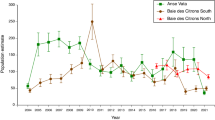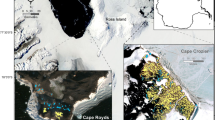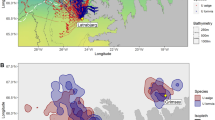Abstract
There is long-standing disagreement over the way in which seabird populations are regulated1. They may be regulated by density-dependent mortality during winter as a consequence of food shortage2–4, shortage of nest sites5–7, social factors8, or not regulated at all9. Ashmole10,11 argued that for tropical seabirds, density-dependent mortality of adults outside the breeding season is most unlikely because intraspecific competition for food close to the colony would result in prey depletion, causing adults to travel increasing distances for food as colony size increased.Breeding numbers could be regulated through a density-dependent reduction in reproductive output resulting from reduced rates of provisioning of chicks. This mechanism may not apply to seabird colonies in higher latitudes, however, because seasonal production might provide superabundant food supplies during the breeding season. Recent studies of the quantity of food consumed by breeding seabirds12–15 suggest that prey depletion also occurs in temperate regions and invites a critical test of Ashmole's hypothesis. We present here an analysis of interactions between spatial distribution and size of seabird breeding colonies and provide support for Ashmole's suggestion that seabird numbers may be limited by intraspecific competition for food around colonies during the breeding season.
This is a preview of subscription content, access via your institution
Access options
Subscribe to this journal
Receive 51 print issues and online access
$199.00 per year
only $3.90 per issue
Buy this article
- Purchase on Springer Link
- Instant access to full article PDF
Prices may be subject to local taxes which are calculated during checkout
Similar content being viewed by others
References
Birkhead, T. R. & Furness, R. W. Symp. Br. Ecol. Soc. (Blackwell, London, in the press).
Lack, D. The Natural Regulation of Animal Numbers (Oxford University Press, 1954).
Lack, D. Population Studies of Birds (Oxford University Press, 1966).
Lack, Proc. XIV int. Orn. Congr. 14, 3–42 (1967).
Potts, G. R., Coulson, J. C. & Deans, I. R. J. Amin. Ecol. 49, 465–484 (1980).
Duffy, D. C. Auk 10, 680–688 (1983).
Manuwal, D. A. Thesis, Univ. Calif. Los Angeles (1972).
Wynne-Edwards, V. C. Animal Dispersion in Relation to Social Behaviour (Oliver & Boyd, Edinburgh, 1963).
Nelson, J. B. Seabirds Their Biology and Ecology (Hamlyn, London, 1980).
Ashmole, N. P. Ibis 103 b, 458–473 (1963).
Ashmole, N. P. Avian Biology Vol. 1, 112–286 (Academic, London, 1971).
Wiens, J. A. & Scott, J. M. Condor 77, 439–452 (1975).
Furness, R. W. J. Anim. Ecol. 47, 39–53 (1978).
Furness, R. W. & Cooper, J. Mar. Ecol. Prog. Ser. 8, 243–250 (1982).
Schneider, D. & Hunt, G. L. Mar. Biol. 67, 337–344 (1982).
Nelson, J. B. The Sulidae: Gannets and Boobies (Oxford University Press, 1978).
Murray, S. Scott. Birds 11, 205–211 (1981).
Dennis, R. H. Scottish Birds Annual Birds Reports (Scottish Ornithologists' Club, 1979–83).
Bary, B. Mck. J. Fish. Res. Bd Can. 20, 789–815 (1963).
Harris, M. P. Br. Birds 69, 239–264 (1976).
Cramp, S., Bourne, W. R. P. & Saunders, D. The Seabirds of Britain and Ireland (Collins, London, 1974).
Richardson, M. G. Shetland Bird Report for 1982, 54–64 (Shetland Bird Club, 1983).
Potts, G. R. J. Amin. Ecol. 38, 53–102 (1969).
Pearson, T. H. J. Amin. Ecol. 37, 521–552 (1968).
Harris, M. P. & Hislop, J. R. G. J. Zool., Lond. 185, 213–236 (1978).
Author information
Authors and Affiliations
Rights and permissions
About this article
Cite this article
Furness, R., Birkhead, T. Seabird colony distributions suggest competition for food supplies during the breeding season. Nature 311, 655–656 (1984). https://doi.org/10.1038/311655a0
Received:
Accepted:
Issue Date:
DOI: https://doi.org/10.1038/311655a0
This article is cited by
-
Fledging behaviour in colonial auks from the Alcini tribe: comparison of Little Auk Alle alle and Brünnich’s Guillemot Uria lomvia
Polar Biology (2023)
-
Important marine areas for endangered African penguins before and after the crucial stage of moulting
Scientific Reports (2022)
-
Territoriality constrains foraging activity and has carry-over effects on reproductive investment
Marine Biology (2022)
-
At-sea distribution, movements and diving behavior of Magellanic penguins reflect small-scale changes in oceanographic conditions around the colony
Marine Biology (2022)
-
Foraging behaviour and diet of Brown boobies Sula leucogaster from Tinhosas Islands, Gulf of Guinea
Marine Biology (2021)
Comments
By submitting a comment you agree to abide by our Terms and Community Guidelines. If you find something abusive or that does not comply with our terms or guidelines please flag it as inappropriate.



